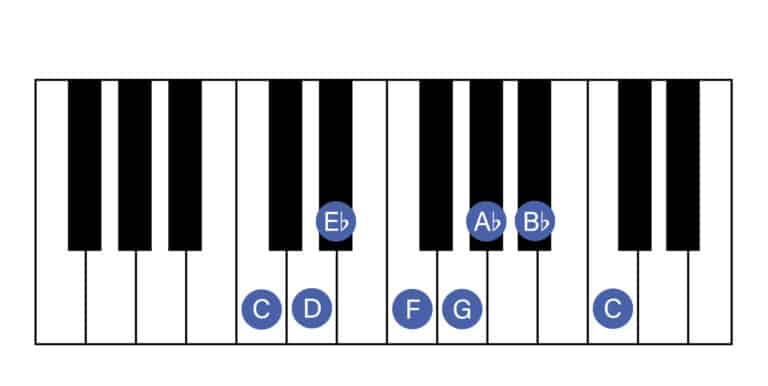Last Updated on February 19, 2022 by IDS Team
A musical scale is a collection of notes that when played together sound “at home”, “normal” and “natural”. If you don’t consider scales and just compose by ear, your music will risk sounding “dissonant”, which basically means non-musical. The Major and Minor musical scales are the two most important scales in western music and are found everywhere from Christmas music to radio hits. They are some of the foundational building blocks of music theory and one of the first places many musicians begin with their theory knowledge. Generally, major scales sound ‘happy’ and ‘minor’ scales sound sad; nevertheless, a deeper look shows their musical makeup is inherently different. When used in compositions, it can sometimes be hard to tell them apart – chord progressions based off major scales can contain minor chords, and progressions based off minor scales can contain major chords. Breaking down the music theory can help you understand which is which and how to use them in composition.
How to Use the Major Musical Scale in Composition
The major scale is incredibly versatile and used in blues, rock, singer songwriter, RnB, folk, and much more. Like any scale, it is a sequence of intervals (gaps between notes) which creates a set of notes to be used to build chords and compose. It is identical to Ionian mode in modal music. Generally it has an upbeat, climactic, ‘happy’ feeling to it.
To use the major scale, it is easiest to focus on chord progressions. The most common chord progression in the major scale is the I – VI – V chord progression. Notes are numbered in order and each note has a particular chord attached to it These can be major or minor depending on which note in the scale the chord is based off, but the general pattern for the major scale uses Roman numerals to number the chords as follows, with lower case numerals indicating minor chords and upper case numerals indicating major.
I – ii (minor) – iii – IV – V – vi – VII(7)
The fully major I – IV – V progression is often followed by a minor vi chord which provides a sense of tension before the progression resolves to I again. This enables the chord progression to have a mixture of emotions which makes the composition more interesting and varied.
How to Use the Minor Musical Scale in Composition
The minor scale can be used similarly – by building chord progressions based on the notes of the scale. Like the major scale, each chord aligns to each note. However, the sequences of steps between the notes is different. Because the scale resolves (gives a feeling of completion) to a minor note, it is helpful to keep in mind that a composition generally needs major chords to lighten the atmosphere and ensure the song does not get too tense – except when deliberately trying to create a sense of sadness, but also of mystery, suspense, or eeriness.
The minor scale contains a diminished chord, also known as a tritone, which has a flattened fifth. This chord has a particularly tense and eerie feeling which is often used in horror movies or music like heavy metal. The chord numbering for the minor scale goes like this:
I – ii(diminished) – III – iv – v – VI – VII
Both major and minor scales can be used to create basslines in genres ranging from rock, indie, punk, or underground music set up. Knowing the scale means you can work out the related chord progressions which are possible – and from there identify the bass note of each chord.
These bass notes can be used to create a bassline which follows the chord progression tying together a composition in a way which is both satisfying and relatively simple to compose.
With a little bit of practice, the musical scales will come second nature to you!
Want to explore more music theory? Then come on down to our Musical Education category where we have prepared a lot of articles similar to this one – click here!
Is it Possible to Use Both Major and Minor Musical Scales in a Composition?
It is possible to switch from a major key (one based off a major scale) and a minor key in the same composition. This is done with a pivot chord which balances the different moods of the scales. It is a creative way of using the major and minor musical scale in composition, although it takes some music theory knowledge. There are many ways to learn theory in depth – but one of the most comprehensive and accessible courses on the internet can be found on Udemy. Jason Allen’s comprehensive music theory course, teaches theory at a college level, covering chord inversions, harmony, and even technical analysis of the building blocks of music, such as what it means to be in tune. Extremely satisfying for musical inspiration, it has racked up five-star reviews and been enjoyed by over 90,000 students so far.

Variations on the Minor Scale
There are several variations on the minor scale, but two of the most common are harmonic minor and melodic minor. Harmonic minor has a tense sound which comes from raising the seventh note of the scale a half step upwards, making it sharp. The sound is often associated with Eastern scales such as the Persian scale – which uses these kinds of intervals – yet it is also found in Western music from the medieval era onwards.
As well as the spooky sounding diminished chord, keys based off the harmonic minor scale also contain an augmented chord – with a raised, as opposed to flattened fifth. This creates a complex, jazzy sound which can be used to provide interest and relief – very different from the diminished chord.
This is the numbering of the chords for the harmonic minor scale:
I – ii(dim) – iii(aug) – iv – V – VI – vii (dim)
On the other hand, the melodic minor musical scale differs from the natural minor scale by raising the sixth and seventh notes up a half step when ascending. When descending, the scale becomes the same as the natural minor scale.
Ascending:
I – ii – III – IV – V – vi – vii
Descending:
VII – VI – v – iv – III – ii(dim) – I
Digital Music Theory Tools – Composing With Plugins
Music theory is a topic which, once explored, can be an endless source of fascination and inspiration. Sometimes, it can be hard to know where to stop, or what is and isn’t needed for composing a song. For those who wish to cut through the noise, some nifty plugins can help with doing so right alongside the composition. This does not mean that you don’t need to know music theory, it just means that there are tools to make your life a little easier when you try out different composition parts.
Scaler 2 by Plugin Boutique is fast, intuitive, and great for multitasking. You can get the plugin by clicking here! Reviewed in Beat Magazine and MusicTech, it has so far been given the thumbs up by over 30,000 musicians.



